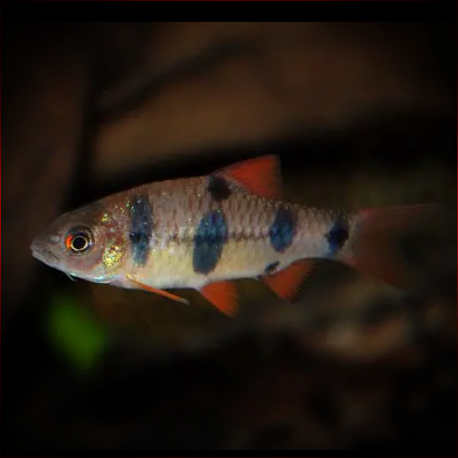More info
Datasheet
| Minimum Tank Size | 240 litres / 63.40 US gallons |
| Maximum Size | 12.0cm / 4.72inches |
| Temperature | 18°C / 64.40°F - 28°C / 82.40°F |
| Hardness | 2.02dgH / 36ppm - 12.05dgH / 215ppm |
| pH | 6.0-7.5 |
General Description
The Clown Barb, scientifically known as Barbodes dunckeri, is a peaceful and schooling species often confused with its congener B. everetti. Distinguished by larger body markings and lacking a distinctive dark blotch at the dorsal fin base, B. dunckeri was formerly classified under the genus Puntius before being transferred to Barbodes. This omnivorous species showcases a striking color pattern, with adult males displaying more intense hues.
Aquarium Setup
To maintain B. dunckeri in captivity, a tank of at least 240 litres is recommended. Mimicking a flowing stream or river environment is advised, with a substrate of rocks, sand, gravel, and driftwood. Hardy aquatic plants like Microsorum or Anubias can be incorporated. Clean water with moderate movement and high dissolved oxygen levels is crucial, requiring regular water changes and a pH range of 6.0-7.5.
Behavior
Being a schooling species, it is ideal to keep at least 6 or more specimens in a community aquarium. This helps reduce skittish behavior and enhances the natural display. Clown Barbs are generally peaceful but may display hierarchical behavior within the group. When selecting tankmates, compatibility with similarly-sized peaceful fish is essential, as aggressiveness is usually contained within the schooling dynamic.
Feeding and Diet
As foragers, Clown Barbs thrive on a varied diet of live, frozen, and dried foods. Their diet includes worms, insects, crustaceans, and plant material. In captivity, they readily accept small live and frozen foods such as bloodworms, Daphnia, and Artemia, supplemented with high-quality flakes and granules for optimal health and coloration.
Reproduction & Dimorphism
In terms of reproduction, Clown Barbs are egg-scattering spawners with no parental care. To maximize fry yield, a controlled breeding setup is recommended. Adult conditioning in a separate tank with proper spawning substrate and dim lighting can facilitate successful spawning. Adult males exhibit more vivid colors and tubercles on the head during breeding, while females tend to be larger and less colorful.
Habitat and Distribution
The distribution of B. dunckeri includes regions like Bukith Timah, Singapore, and Peninsular Malaysia. This species likely prefers forest streams, and its presence in the ornamental trade indicates farm-raised specimens. While its specific habitat requirements are unconfirmed, a preference for pristine waters is noted, emphasizing the need for clean and well-oxygenated aquarium conditions.

